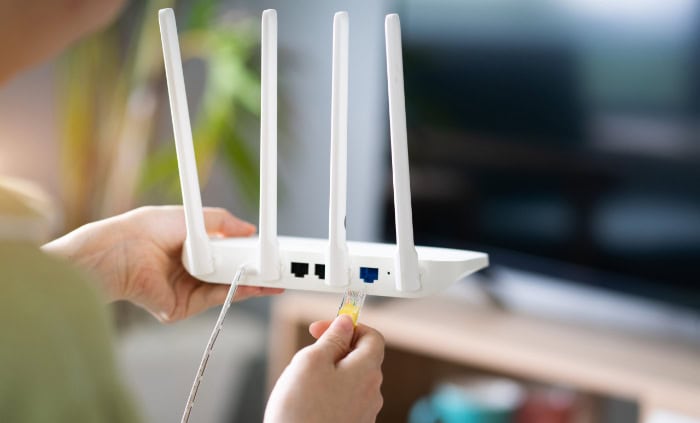Jitter vs. Ping: What’s the Difference?

Network performance can make or break your online experience. From video calls freezing mid-conversation to gaming sessions ruined by lag, poor network metrics directly impact how we interact in real-time over the internet.
Two critical measurements – ping and jitter – play distinct roles in determining the quality of your connection. Ping represents how fast your data travels to its destination and back, while jitter shows how consistent that travel time remains.
For gamers, streamers, remote workers, and anyone who relies on real-time communication, these metrics matter significantly. High ping creates noticeable delays in your actions, while excessive jitter causes stuttering and unpredictable performance.
Both can disrupt your online activities, but they do so in different ways.
What is Ping?
Network responsiveness plays a vital role in our online interactions, and ping stands as one of the most fundamental measurements of this responsiveness. Ping represents the round-trip time required for a data packet to travel from your device to a destination server and back again, measured precisely in milliseconds (ms).
This metric serves as a direct indicator of how quickly your connection responds to requests.
Definition and Technical Aspects
Ping originated from sonar technology, where sound waves bounce off objects to determine their distance. In networking, ping operates on a similar principle – sending small data packets called Internet Control Message Protocol (ICMP) echo requests to a target server.
The server then returns these packets, and the total time taken for this round trip becomes your ping measurement.
For example, a ping of 50ms means it takes 50 milliseconds for your data to reach the server and return to your device. Lower ping values indicate better network performance, with professional gamers often seeking ping rates below 20ms for optimal gameplay.
Conversely, ping values exceeding 150ms can create noticeable delays in real-time applications.
Impact on Network Performance
Ping significantly influences how responsive your online activities feel. In online gaming, low ping allows for immediate response to player actions, creating smooth and reactive gameplay.
A player with 20ms ping will see their actions reflected almost instantly, while someone with 200ms ping experiences a fifth-of-a-second delay between pressing a button and seeing the result.
Video conferencing provides another clear example of ping’s importance. During calls, high ping can cause awkward delays in conversation, where participants might talk over each other due to delayed audio transmission.
These delays can disrupt natural conversation flow and make meetings less productive.
Common Causes of High Ping
Several factors contribute to elevated ping times. Physical distance represents a fundamental limitation – data traveling from New York to Tokyo must cover roughly 6,800 miles, creating inherent delays regardless of connection quality.
This explains why connecting to geographically closer servers typically results in better ping times.
Network congestion significantly impacts ping rates. During peak usage hours, when numerous users simultaneously access the same network resources, data packets face increased traffic and potential queuing delays.
This congestion often occurs at various points along the connection path, from your local network to your Internet Service Provider’s infrastructure.
Hardware limitations also play a crucial role. Outdated routers might struggle to process network traffic efficiently, adding unnecessary delays to your connection.
Similarly, using wireless connections instead of wired ethernet can introduce additional latency, particularly in environments with significant wireless interference.
Network routing efficiency affects ping times as well. Your data packets might not always take the most direct path to their destination, instead traveling through multiple intermediate servers and networks.
Poor routing configurations or network issues along these paths can result in higher ping times, even when your local connection appears strong.
These various factors often combine to affect your overall ping performance, making it essential to consider multiple potential solutions when addressing high ping issues.
What is Jitter?

While ping measures the time data packets take to travel, jitter focuses on the consistency of these travel times. Network jitter represents the variation in delay between data packets arriving at their destination.
This variation can significantly impact the quality of real-time communications, making it a crucial metric for anyone relying on stable internet connections for their daily activities.
Definition and Technical Aspects
Jitter occurs naturally in packet-switched networks, where data is broken into smaller packets and sent across various network paths. Each packet might take slightly different routes to reach its destination, resulting in varying arrival times.
Measured in milliseconds (ms), jitter calculations compare the delays between consecutive packets to determine how much these delays fluctuate.
For example, if one packet arrives with a 20ms delay and the next arrives with a 40ms delay, the jitter value would be 20ms. Modern networks typically aim for jitter values below 30ms to maintain smooth performance.
Higher values can create noticeable disruptions in applications that rely on consistent packet delivery.
Impact on Network Performance
Jitter’s effects become most apparent in applications requiring real-time data transmission. During video calls, high jitter can cause video frames to appear jerky or frozen, while audio might sound robotic or broken.
These issues occur because packets arriving at irregular intervals disrupt the smooth flow of audio and video data.
Voice over IP (VoIP) systems prove particularly sensitive to jitter. A conversation that should flow naturally might become fragmented, with words cutting out or arriving out of sequence.
This degradation can make professional calls frustrating and potentially harm business communications.
Online gaming suffers similarly from high jitter. Players might experience rubber-banding, where their character appears to jump back and forth, or encounter delayed hit registration in competitive scenarios.
These inconsistencies can severely impact gaming performance and enjoyment, especially in fast-paced games where split-second timing matters.
Common Causes of High Jitter
Network congestion stands as a primary cause of high jitter. As networks handle increasing amounts of traffic, routers and switches must queue packets, leading to inconsistent delivery times.
This issue often becomes more pronounced during peak usage hours, such as evening times when many users stream videos or play online games simultaneously.
Wireless interference creates another significant source of jitter. Wi-Fi signals can face disruption from various sources, including neighboring networks, electronic devices, and physical obstacles.
These interruptions force packets to be retransmitted, creating irregular delays in data transmission.
Network hardware quality and configuration play crucial roles in managing jitter. Outdated or overloaded routers might struggle to process traffic efficiently, introducing unnecessary variations in packet timing.
Similarly, networks without proper Quality of Service (QoS) settings may fail to prioritize time-sensitive traffic, allowing less critical data transfers to interfere with real-time applications.
Route changes and network instability can also contribute to jitter. Internet traffic often travels through multiple networks and providers to reach its destination.
Changes in these routes, whether due to network problems or routine maintenance, can create inconsistent packet delivery times. This situation becomes particularly problematic for international connections, where data must traverse numerous network boundaries.
Comparing Jitter vs. Ping: Key Differences

While both ping and jitter affect network performance, they measure distinct aspects of your connection and impact online activities differently. These metrics work together to paint a complete picture of network quality, yet their individual effects and optimal values vary significantly across different applications and use cases.
Measurement Focus and Technical Distinctions
Ping measures the total time required for data to travel round-trip between two points on a network. Think of ping as the overall speed of your connection – similar to measuring how long it takes to drive from point A to point B.
A ping of 50ms means your data consistently takes 50 milliseconds to make this round trip.
Jitter, however, focuses on the variation in these travel times. Using the same driving analogy, jitter would measure how much your trip time varies from day to day.
If one packet takes 50ms to arrive, and the next takes 70ms, you have a jitter of 20ms. This variation can occur even when your average ping remains constant.
Impact on Different Applications
These metrics affect online activities in notably different ways. High ping creates a consistent delay in all actions – imagine pressing a button and waiting a fixed amount of time before seeing the result.
In online gaming, this manifests as a predictable lag where your actions always appear slightly delayed, but the delay remains consistent.
Jitter produces more erratic effects. Rather than a consistent delay, high jitter causes sporadic disruptions.
During video calls, high ping might create a constant delay in conversation, but high jitter makes people’s voices cut in and out unpredictably.
In gaming, high jitter causes characters to teleport or move erratically, making the game far more difficult to play than with just high ping alone.
Acceptable Values and Performance Benchmarks
Different applications have varying tolerances for ping and jitter. For general web browsing, ping values under 100ms typically provide smooth performance, while gaming often requires ping below 50ms for competitive play.
Professional esports players often seek ping rates under 20ms to maintain peak performance.
Jitter tolerances tend to be stricter. Most real-time applications perform best with jitter below 30ms.
Video conferencing platforms typically recommend jitter values under 20ms for optimal quality. VoIP systems might still function with higher ping, but jitter above 30ms can make conversations unintelligible due to packet arrival irregularity.
Application-Specific Requirements
Online gaming serves as an excellent example of how these metrics interact. First-person shooter games might remain playable with consistent ping up to 150ms, allowing players to adjust their timing accordingly.
However, these same games become virtually unplayable with just 50ms of jitter, as players cannot predict when their actions will register.
Video streaming platforms handle these metrics differently. They can compensate for high ping by increasing buffer sizes, essentially downloading content further ahead of playback.
However, high jitter forces these platforms to maintain larger buffers, potentially leading to longer initial loading times and higher memory usage.
Business applications, particularly VoIP and video conferencing, require balanced performance in both metrics. While they can often tolerate ping up to 150ms, jitter must typically stay below 20ms to maintain professional call quality.
This requirement explains why many businesses invest in dedicated connections with guaranteed performance levels for their communication needs.
How to Measure Ping and Jitter

Measuring network performance metrics requires the right tools and knowledge to interpret the results accurately. Various tools exist for both basic and advanced measurements, ranging from built-in system utilities to specialized software designed for network professionals.
Built-in System Tools
The most basic and widely available tool for measuring ping is the command prompt or terminal’s ping command. On Windows, you can open Command Prompt and type “ping google.com” to see basic ping statistics.
This command sends four packets by default and displays the round-trip time for each, along with minimum, maximum, and average values.
For Mac and Linux users, the process remains similar, though these systems offer additional options through the terminal. The command “ping -c 4 google.com” sends exactly four packets, providing comparable results to the Windows version.
These built-in tools prove particularly useful for quick network troubleshooting and basic connectivity tests.
Online Testing Tools
Popular speed testing websites like Speedtest.net and Fast.com have evolved beyond simple bandwidth measurements to include detailed latency statistics. These sites offer user-friendly interfaces and can measure both ping and jitter simultaneously.
Their servers are distributed globally, allowing users to test connections to various geographical locations.
Many internet service providers also offer their own testing platforms, which can provide more accurate results specific to their networks. These tools often include additional features such as server selection and detailed performance graphs showing variations over time.
Professional Network Diagnostic Software
For more comprehensive analysis, professional tools like PingPlotter, WinMTR, and NetSpot provide detailed network performance data. These applications can run continuous tests over extended periods, helping identify patterns in network behavior and pinpoint specific problems.
VoIP-specific testing tools such as VoIP Spear and MySpeed focus particularly on metrics critical for voice and video communication.
These specialized tools measure jitter more accurately and often provide additional metrics like packet loss and Mean Opinion Score (MOS) for voice quality assessment.
Interpreting Test Results
Reading ping results requires attention to several values. Single ping measurements below 20ms indicate excellent connectivity, while values between 20-100ms remain acceptable for most applications.
Readings above 150ms might cause noticeable delays in real-time applications, and anything exceeding 300ms could make many online activities impractical.
Jitter interpretation focuses on consistency rather than absolute values. Variations under 20ms typically go unnoticed in most applications.
However, jitter between 20-50ms might cause minor quality issues in real-time communications. Values above 50ms often result in significant quality degradation, especially in VoIP calls and online gaming.
Conducting Proper Tests
To obtain reliable measurements, run tests during different times of day and under various network conditions. Peak usage hours often show different results compared to off-peak periods.
Multiple tests provide a more accurate picture of your network’s typical performance.
Consider testing against different servers and locations relevant to your usual online activities. A connection might show excellent performance to local servers but struggle with international connections.
This information helps identify limitations in your network setup and guides potential improvements.
Advanced Analysis Techniques
Professional tools often provide waterfall graphs and route analysis features. These visualizations help identify where delays occur along the network path.
Such detailed analysis proves particularly valuable for businesses requiring optimal network performance or gamers seeking to minimize latency to specific game servers.
Some tools also offer long-term monitoring capabilities, generating reports that track performance trends over days or weeks. This historical data helps identify recurring issues and can provide evidence when discussing service quality with internet providers.
Troubleshooting and Reducing High Ping and Jitter

Network performance issues can significantly impact your online experience, but numerous solutions exist to improve both ping and jitter.
From simple hardware adjustments to advanced configuration changes, these improvements can transform an unstable connection into a reliable one for gaming, video conferencing, and other real-time applications.
Hardware Solutions and Physical Connections
The most effective solution for reducing both ping and jitter often starts with switching from wireless to wired connections. Ethernet cables provide more stable connections and eliminate interference issues common with Wi-Fi.
Modern Cat6 or Cat7 cables support high speeds and maintain consistent performance over longer distances.
Router placement and quality play crucial roles in network stability. Older routers might struggle with modern network demands, leading to increased latency and inconsistent performance.
Upgrading to a current-generation router with advanced features like MU-MIMO technology and better processing power can significantly improve network performance.
Internet Service Optimization
Your internet service directly affects network performance. Higher bandwidth plans don’t always guarantee better ping or jitter, but they provide more headroom for multiple devices and applications.
Contact your Internet Service Provider (ISP) to discuss available options and potential network bottlenecks in your area.
Server selection can dramatically impact ping times. Many online services offer multiple server locations – choosing servers geographically closer to your location typically results in lower ping.
Games, streaming services, and VPN providers often allow manual server selection, helping optimize your connection for specific activities.
Managing Network Traffic
Background applications can consume significant bandwidth and create network congestion. Identify and limit bandwidth-heavy activities like automatic updates, cloud backups, or background downloads during times when you need optimal performance.
Many operating systems provide tools to monitor and control network usage per application.
For households with multiple users, implementing bandwidth management becomes essential. Modern routers allow you to set bandwidth limits for different devices or applications, preventing any single activity from overwhelming the network and causing performance issues for others.
Advanced Router Configuration
Quality of Service (QoS) settings represent one of the most powerful tools for optimizing network performance. These settings allow you to prioritize specific types of traffic, ensuring that time-sensitive applications receive bandwidth priority.
For example, you can configure your router to prioritize VoIP calls and gaming traffic over general web browsing or downloads.
Most modern routers offer customizable QoS profiles. Gaming profiles typically prioritize consistent, low-latency connections, while streaming profiles focus on maintaining steady bandwidth.
Experimenting with these profiles can help find the optimal configuration for your specific needs.
Specialized Solutions for VoIP and Gaming
VoIP systems benefit from jitter buffers, which temporarily store incoming packets to compensate for varying arrival times. While this introduces slight additional latency, it significantly improves call quality by smoothing out packet delivery.
Many VoIP applications automatically adjust buffer sizes, but manual configuration might provide better results in challenging network conditions.
Gaming-specific solutions include port forwarding and DMZ configuration for consoles or gaming PCs. These settings can improve connection stability and reduce latency by allowing direct communication between your gaming device and game servers.
However, implement these features carefully as they can impact network security.
Network Monitoring and Maintenance
Regular network maintenance helps prevent performance degradation over time. This includes updating router firmware, cleaning up old network configurations, and periodically checking for interference sources.
Maintaining a network performance log can help identify patterns and troubleshoot recurring issues.
Consider using network monitoring tools to track performance metrics over time. These tools can alert you to potential problems before they severely impact your online activities and provide valuable data for discussions with your ISP about service quality.
Environmental Considerations
Physical obstacles and electronic interference can significantly affect network performance, particularly for wireless connections. Metal objects, thick walls, and electronic devices operating on similar frequencies can all contribute to connection instability.
Repositioning network equipment or removing sources of interference can lead to immediate improvements in both ping and jitter.
Conclusion
Network performance metrics like ping and jitter directly influence your daily online activities. Ping measures how quickly your data travels, affecting response times in gaming and real-time applications.
Jitter reflects connection stability, impacting the smoothness of video calls and streaming services. Both metrics work together to determine your overall online experience.
Modern tools make measuring these values straightforward, from simple command-line utilities to comprehensive network monitoring software. Regular testing helps identify potential issues before they disrupt important activities.
Solutions range from basic hardware upgrades to advanced router configurations, offering multiple paths to improve your connection quality.
Maintaining optimal network performance requires attention to both hardware and software elements. Wired connections, strategic router placement, and proper traffic management create a foundation for reliable connectivity.
Combined with appropriate QoS settings and regular maintenance, these approaches help minimize latency and maximize stability for all your online needs.
Remember that perfect network conditions rarely exist, but implementing the right combination of solutions can significantly enhance your connection quality. Focus on the improvements that matter most for your specific activities, and you’ll achieve a more reliable and responsive online experience.


